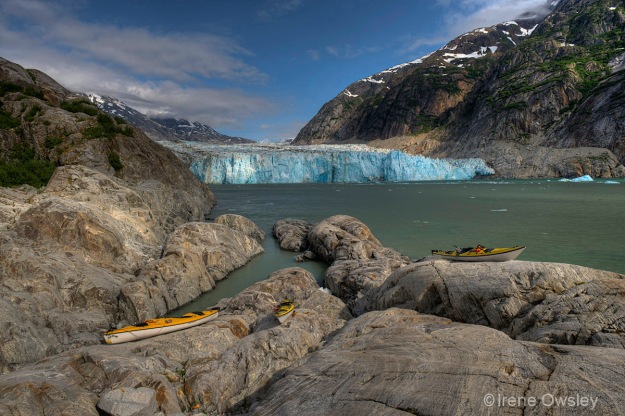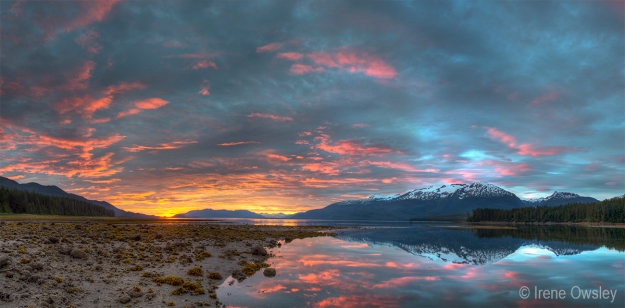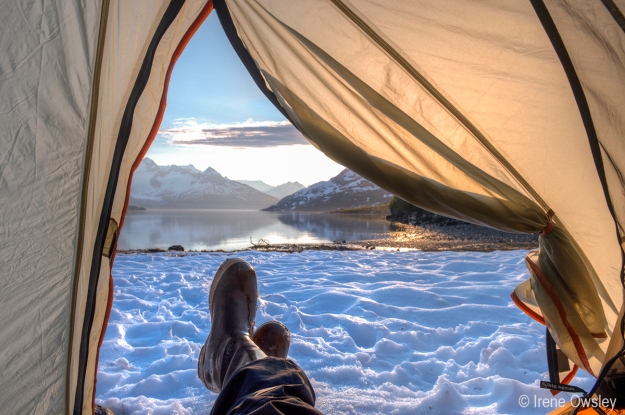Welcome to guest blogger Irene Owsley, whose images from three artist residencies in Alaska's wilderness have given all of us a new perspective on the wild. This guest post first appeared on the blog Thinking Wilderness.
Traveling by kayak for 8 days with two wilderness rangers during an artist residency program in the Tracy Arm-Ford’s Terror Wilderness of the Tongass National Forest, Southeast Alaska, I was intensely aware of a world defined by moving water. We paddled up the fjord, filled water jugs from cascading waterfalls, dodged growlers and bergy bits in our kayaks and admired icebergs from a safe distance.

View from my kayak, Harriman Fjord, Prince William Sound. L-R: Cascade, Barry & Coxe Glaciers. Nellie Juan-College Fjord Wilderness Study Area, Chugach National Forest.
It rained occasionally, and the sun was elusive. Fog clung to the spruce branches above us, leaving fat droplets on the undergrowth we hiked through. At the end of Endicott Arm loomed Dawes Glacier, the great carver of this landscape. We camped nearby, next to a glacial stream, itself a microcosm of the mighty glacier beyond, alive with sound and movement where water was constantly flowing, crushing and moving rock, working on the palette of the landscape.

Single Shot: View of Dawes Glacier, Endicott Arm, with kayaks in the foreground. Tracy Arm-Ford’s Terror Wilderness, Tongass National Forest, Southeast Alaska
And that’s what I was doing, too, trying to make an image of these dynamic forces at work, setting up my tripod in the shallow part of the stream. I was captivated by the smooth granite slide, the multicolored rocks at its base, and the tide which moved in and out, its flow competing with the outpouring from the mountain behind. The setting was primeval, exuding the essence of self-willed landscape, to echo the words of Howard Zahniser, principal author of The Wilderness Act of 1964.

Sunset at low tide, Sanford Cove. Chuck River Wilderness, Tongass National Forest, Southeast Alaska.
At this spot, I shot several vertical images and later stitched them together in Photoshop to create a panorama of the scene that had made such an impression on me. It was one of several panoramas I made as my contribution to the Voices of Wilderness artist residency program conceived, organized and run by a truly dedicated wilderness ranger and artist, herself, Barbara Fischer Lydon, now based out of the Glacier Ranger District in Girdwood, Alaska.

View from Black Sand Beach, Harriman Fjord, Prince William Sound. L-R: Cascade & Coxe Glaciers. Nellie Juan-College Fjord Wilderness Study Area, Chugach National Forest.
The goal of the Voices of Wilderness program is to bring artists into the wilderness and allow them to create pieces, in their particular medium, that speak to the values of wilderness. The work of many artists was collected over a four-year period for a 2014 exhibition that traveled to seven museums and communities in Alaska, culminating with a show at the Anchorage Museum – all in celebration of the 50th anniversary of The Wilderness Act. The traveling exhibition brought huge awareness to this milestone in conservation history and spurred public engagement with wilderness, both through the efforts of the artists and the participating public lands throughout Alaska.

Single Frame: View from my tent down Harriman Fjord, Prince William Sound. Nellie Juan-College Fjord Wilderness Study Area, Chugach National Forest.
For me personally, the value of my participation in Voices of the Wilderness has been immeasurable. It offered me the unique opportunity for self-supported living in designated wilderness areas in Alaska for 7-10 days at a time which inspired new expression (through my photography) and the articulation of much that lay buried within – this love of all things wild. The experience lifted me to a higher level of understanding where “wild” is concerned and made me acutely aware of the critical need to preserve and support what wild areas we still have. Just as importantly, I was introduced to other artists and wilderness activists who became models to me through their fierce support for wilderness.
![[FEATURED IN SMITHSONIAN EXHIBITION] Glacial stream, Endicott Arm. Tracy Arm-Ford’s Terror Wilderness, Tongass National Forest, Southeast Alaska.](https://thinkingwilderness.files.wordpress.com/2015/02/owsley_120722_streambed_endicott.jpg?w=625&h=316)
[FEATURED IN SMITHSONIAN EXHIBITION]
Glacial stream, Endicott Arm. Tracy Arm-Ford’s Terror Wilderness, Tongass National Forest, Southeast Alaska.
Glacial stream, Endicott Arm. Tracy Arm-Ford’s Terror Wilderness, Tongass National Forest, Southeast Alaska.
And not least, my image of “Glacial Stream, Endicott Arm,” (above) is included in the Smithsonian’s exhibition, “Wilderness Forever,” at the National Museum of Natural History, one of thirteen finalists chosen from over 5000 entries. My image was awarded first place in the professional category for “Scenic Landscape.”

View of Tracy Arm near Sawyer Glacier. Tracy Arm-Ford’s Terror Wilderness, Tongass National Forest, Southeast Alaska.
Irene Owsley, a freelance photographer, specializes in the outdoors and travel, particularly in northern regions. Her work has appeared in such magazines as Canoe & Kayak, Sierra, National Parks, Earthwatch, and Natural History and in the publications of several conservation organizations. Since 2011, she has been accepted to participate in three artists residencies in Alaska’s wilderness. A long-time resident of Washington DC until just recently, Owsley found the “wild” in this large metropolitan area by creating a body of work called “Wild Washington,” with images from the riparian areas along the Potomac River. She has exhibited her work in galleries and has been profiled in Rangefinder, Photographer’s Forum, and Nikon World magazine. A new resident of New Mexico, Owsley is focused on producing large scale panoramic landscapes as a way to explore her new home. She serves on the national board of ASMP (American Society of Media Photographers), promoting best business practices for photographers. www.ireneowsley.com

No comments:
Post a Comment